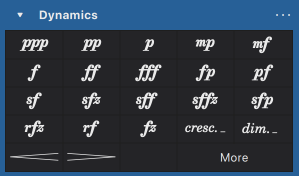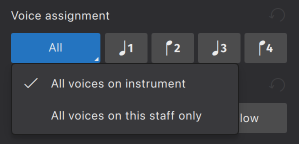Dynamics
Adding dynamics to your score

All dynamics symbol objects are in the Dynamics palette. To add a dynamics symbol to the score:
- Select one or more notes, and then click an item in the Dynamics palette; or
- Drag an item from the Dynamics palette onto a note.
Dynamics properties
Dynamics can be edited in Properties panel. The following options are available:
- Scale: Size of dynamics symbols
- Avoid barlines: Toggles whether dynamics markings avoid collisions with barlines.
- Voice assignment: Choose to which voice the selected dynamic is assigned. Affects both the dynamic's position and playback.
- Position: Choose whether the selected dynamic sits above or below the stave.
- Center between staves: On instruments with more than one stave, choose whether the selected dynamic sits vertically centered between two staves. Can be used in combination with Position.
- Alignment with notehead (under Show more) : For dynamics symbols with expression text added, the combined element can be justified to the right of the notehead, or aligned to the center of the notehead.
- Frame (under Show more): Add a square or circular frame to the dynamic marking and customize its styling
To edit the score-wide settings, see the Dynamics style section.
Dynamics and playback
In MuseScore 4.4 onwards, dynamics symbols (including hairpins) can apply independently to individual voices and staves. A dynamic affects its assigned voice(s) from the point at which it appears until playback reaches another dynamic in the same voice or a dynamic that affects all voices.
See the dynamics playback compatibility section to learn how this feature works with different sound technologies.
Assigning voices to dynamics
Watch our video on dynamics and voices
In MuseScore Studio 4.4, dynamics and hairpins can be assigned to either All voices or a specific voice from 1–4 using the Voice assignment property. By default, dynamics are assigned to all voices on the instrument.

For instruments with multiple staves, selecting All displays distinct options for
- All voices on this instrument (i.e. applying to all staves) and
- All voices on this staff only (i.e. applying to all voices on the staff to which it is attached only)

To assign a dynamic directly to a specific voice when you add it:
- Select a note or rest in the score
- Click on a dynamic in the palette while holding Ctrl (Mac: Cmd)
- The dynamic will be assigned to the voice of the selected note or rest
To change the voice assignment of an existing dynamic, select it and then either:
- Click one of the buttons in Properties → Voice assignment
- Click one of the voice buttons in the Note input toolbar
- Use the keyboard shortcuts
- For voice 1–4:
Ctrl+Alt+1–4 (Mac: Cmd+Opt+1–4) - For All (or All voices on instrument*):
Ctrl+Alt+0 (Mac: Cmd+Opt+0) - For All voices on this staff only*:
Ctrl+Alt+- (Mac: Cmd+Opt+-)
- For voice 1–4:
*For instruments with multiple staves
Control whether dynamics are assigned to all voices or individual voices by default in Preferences → Note input → Voice assignment.
Positioning dynamics
There are three options available in Format → Style → Dynamics & hairpins → Default positions of dynamics and hairpins which control general dynamics positioning:

- Position determines whether dynamics should be positioned according to their voice assignment ('Based on voice', the default), or should all go 'Above' or 'Below'
- Place above the staff on vocal instruments specifies whether dynamics should go above the stave on vocal staves (on by default)
- Center on grand staff instruments automatically will center dynamics vertically between the staves of multi-stave instruments automatically (on by default)
Voice-based positioning
If the Based on voice position is chosen, voice assignment will affect position of dynamics as follows:
- Voice 1 dynamics go below the stave if there is only one voice at that rhythmic position, and otherwise go above
- Voice 3 dynamics go above the stave
- Voice 2 and 4 dynamics go below the stave
- Dynamics assigned all voices go below the stave
The position of any dynamic can be explicitly overridden via Properties → Position.
Centering dynamics between staves
Dynamics on grand staff instruments (e.g. keyboards, keyboard percussion, harp) can be centered vertically between the staves.
By default, dynamics are automatically centered when:
- There is a stave on the same instrument above or below the dynamic (according to its position relative to the stave to which it is attached) against which it can be centered
- Properties → Voice assignment is set to All voices on instrument
- Properties → Center between staves is set to Auto
- In Format → Style → Dynamics & hairpins, the Center on grand staff instruments automatically option is on
- No manual Y-offset has been applied to the dynamic
You can also manually center dynamics by setting Center between staves to On and configuring Position based on whether the stave to which you want to center is above or below.
Combining dynamics and text
To add a dynamics instruction that combines a dynamics symbol with text, for example poco f:
- Add an appropriate dynamics symbol to your score using the above steps (For poco f, add an f dynamics symbol)
- From the Text palette, add an expression text element to the same note.
- The dynamics symbol and expression text will snap together, allowing you to reposition them as a single unit.
- Double-click the expression text to edit it (For poco f, replace the text with the word poco)
Alternatively, you can double-click a dynamic symbol and type additional text on either side of it.
When an expression text is combined with a dynamic, the size of the expression text can be independently scaled using the Size property in Properties > Text.
Dynamics style
See the main chapter Templates and styles
Format → Style → Dynamics & hairpins contains options for the default positioning, spacing, and size of dynamics and hairpins.
Editing the dynamics font
You can select the font used for dynamics in Format → Style → Score → Musical symbols font. The default font is Leland. You can also change the font for dynamics without changing the font used for other musical symbols in Format → Style → Dynamics & hairpins → Override score font.
Editing expression text style
You can edit expression text style in Format → Style → Text styles → Expression. You can toggle whether expression text automatically snaps to dynamics in Format → Style → Expression text.
Dynamics playback compatibility
Support for voice-specific dynamics varies depending on the sound technology chosen (e.g. SoundFont, VST, or Muse Sounds) and whether the instrument is a single-note-dynamic instrument (i.e. an instrument capable of changing its dynamic on a single note, such as the violin or flute) or a non-single-note-dynamic instrument (e.g. the piano or percussion instruments, where the instrument's dynamic properties begin to recede after a note's initial attack).
In the below table, single-note-dynamic instruments are referred to as SND instruments, while non-single-note-dynamic instruments are referred to as non-SND instruments.
| Sound technnology | Support for individual voices/staves |
|---|---|
| Muse Sounds | Full support for per-voice and per-stave dynamics. |
| SoundFont (MS Basic) | Both SND and non-SND instruments will support dynamics on individual voices. Only non-SND instruments will support dynamics on individual staves. |
| VST | Only non-SND instruments support per-voice and per-stave dynamics. |